Library Day – How to Get Your Kid’s Nose Stuck Inside a Book
It’s library day again!
For the last several weeks, I’ve been running book and reading-related posts on the blog on Tuesdays. So far you’ve seen some book reviews, author interviews, my personal musings, and more. This week I’m bringing you a guest post from a blogger friend many of you already know, Val Newman of My Virtual Vineyard.
Val’s here today to talk about literacy. Literacy is such a buzzword in the world of education, but it is truly an important topic. The subject of literacy is so important to me I spent a significant portion of my graduate studies on it.
Summer reading season is upon us, friends. Whether those words instill joy or dread in your child, Val offers tips and wisdom from her years of experience that will help get even the most reluctant reader’s nose stuck inside a book.
Welcome, Val!
~~~~~~~~~~~~~~~~~~~~~~~~~~~~~~~~~~~
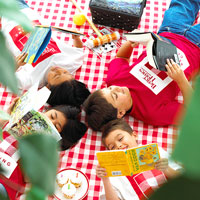 A few things have led me to share information about summer reading for young children from my perspective as an early childhood educator and an avid reader.
A few things have led me to share information about summer reading for young children from my perspective as an early childhood educator and an avid reader.
Lisa wrote a very inspiring post, entitled, The Importance of Talking About Reading. She has instituted a love of reading in her daughter, Zilla, and Zilla reads for pleasure and by choice.
Parents of students I taught in preschool have posted dreaded summer reading lists for middle school and high school students. Killing the love of reading in 0-60.
As an adult, the best part of my summer is spending time at the beach and reading, reading, reading. Getting into those long reads that are just a little too much during the school year when the only reading time is that ten minutes before nodding off to sleep at night.
It’s important to make summer reading fun for kids, too. Building a fun summer reading environment at home can help ease the transition from want to read to have to read, by opening brain channels and developing emotional attachments to books and reading.
Every parent of a young child is a fan of the “bedtime” story. Everyone relaxes, and it signifies the transition between awake and asleep. The sort of reading plan I will outline below, is in addition to this cozy, comfy parent/child time.
Establish a D.E.A.R Time.
Choose a time during the day that works best for you, maybe early morning or that 3-4:00 down time of the day. Select a finite amount of time, depending on the age of the child and designate DEAR time. For working parents, after dinner may be the best time.
You read to them or they read to you, or they read on their own and you read on your own. It is important that you, the parent, participate in DEAR time so the child recognizes this as a special time. Not just a time for the child to be quiet while you do other things.
Choose a place for DEAR time. Change the places around day by day. Build an indoor tent or clubhouse with blankets chairs and tables and have DEAR time inside. Make a block structure to delineate the reading space for the day. Bring a blanket and some pillows in a shady spot in the yard for DEAR time outside. A park, a beach, the library – anyplace where you can spend attentive time reading together.
Be Involved in What Your Child Is Reading
You can help make books and stories come alive to your children by supplementing the information in the book. For example, if your child is reading about a story about fish, take her to the Aquarium. If your child is reading about fire trucks, take him to the Fire Station. Then help your child make connections between what they are reading and the cultural experience – a museum perhaps, or a park or business. Colonial America came alive to me as a child when we visited an exhibit at the Museum of Natural History. A child exposed to outside cultural activities in conjunction with early literacy has a greater opportunity for educational success.(1)
Craft projects which extend the story can enhance comprehension. Drawing or painting pictures, simple puppets for retelling and acting out the story; a Lego representation of a spaceship, perhaps, a pretend pet shop or farm can enrich the reading experience. For older children story maps or posters might be fun.
Make It Fun
If you are reading aloud to your child, use a different voice for each character, ham it up, and be dramatic as possible to convey meaning and enjoyment. If the text is rhyming, or repetitive, make sure to provide the proper rhythm. Use appropriate props while reading the story. Let your child participate with the repetitive text or manipulate the props. The more senses you can involve in the reading experience, the more impact it will have on your child. Cook a character’s favorite food.
My personal picks:
Any books by:
- Eric Carle
- Lois Ehlert
- Pat Hutchins
- Mo Willems
- Laura Numeroff
- David Shannon
- Cynthia Rylant
- The Biscuit Series
- The Magic School Bus Series
- Random House step level readers
- And the list goes on.

Valerie Newman, known to her many students as Ms. Val, is a retired preschool/elementary teacher with vast experience in literacy development for young children. As a writer, blogger at myvirtualvineyard.com, and would-be novelist, she enjoys photography, reading, cooking, beach-combing, and learning new things. She is the mother of two adult children and wife of 30 years to Tim. You can connect with her Facebook page, Twitter, and Pinterest.
~~~~~~~~~~~~~~~~~~~~~~~~~~~~~~~~
Linking up with Literacy Musing Mondays today via Mary Hill at Mary-andering Creatively. Click over and check out some more great book and literacy-related posts there!
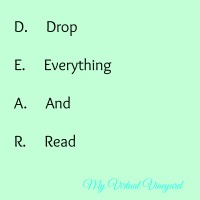
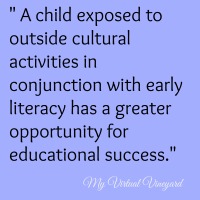
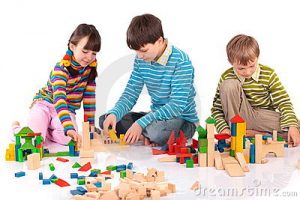
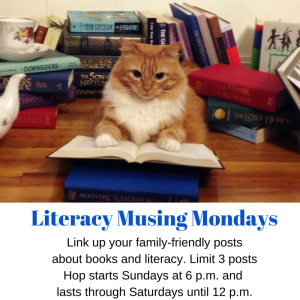


Great post! We just went to the library yesterday for our first installment of summer books. I’m thinking we might try a “Library Crawl” and check out a number of libraries around town. That would be as much for me as my kids…
Louise that’s a great idea! Our library is not amazing and we were just talking about that last night. I’d love to take outr Daughter to some of the better ones in the area.
The Children’s sections of many libraries is full of wonderful activities and nooks for reading. And pride of library card ownership is important for children.
True – Zilla loves hers!
I love DEAR. I am so happy that my daughter is an avid reader and actually drags ME to the library and the bookstore instead of the other way around 🙂
Sounds like my Daughter. Hooray for readers!
You are one of the lucky Moms. Starting a reading connection at an early age is important, so is modeling reading behavior. Good for you!
I think we will add a DEAR time around here as I’m always looking for ideas to get my reluctant reader into a book a bit more often. I love to read but my younger son is not a fan even though his reading comprehension is well above grade level.
I’m sure Val will have some thoughts when she gets here for comments, too, but my suggestion from the teacher perspective is help him figure out what kind of reading and subject matter will interest him – that will help. Email me if you want some suggestions. And reading together, having your kids see that you love it? Very important and a huge influence. They see it as enjoyable and important and that’s what they learn.
Lisa’s comment is spot on. Make sure he is interested in the book and depending on his age, involve his other senses with a book he can manipulate. My son loved books about cars and fire trucks.
Hi, great reminder about how we can use our local libraries to encourage a love for reading. Great post!! Thanks for linking up with us at Literacy Musing Mondays. 😉
Mary, I think the local public library is sometimes forgotten but it really is such a great resource for many things. Last night my Daughter read to the therapy dogs they bring so kids can get practice reading aloud. They have movie nights, game nights, book clubs…lots of great things.
That is wonderful. Princeton University has the best Children’s library I have ever seen. There are all sorts of hideaways and designated reading areas for children. As parents, we need to find out activities that will make reading even more fun.
This is a perfectly timed post as summer has just begun and I’m establishing quiet time/reading time activities. I LOVE D.E.A.R.! Thanks for the reminder.
I’d actually never heard the D.E.A.R. until Val’s post here, but I love it!
I used D.E.A.R. in my Kindergarten classroom as a down time activity after lunch recess. It calmed them down and focused them on learning. The key was to offer a variety of books to peruse during this time. I often paired books with props – a stuffed elephant to go with Elmer by David McKee, a toy dinosaur with a book to match. Good luck with instituting D.E.A.R. at home. I think you will look forward to it every day.
I used to love that we were assigned summer reading as kids in order to pass into the next grade, because I loved reading so much and my parents weren’t really big on pushing it.These are awesome suggestions!
I also loved summer reading – any reading! I truly never understood (and still don’t) people who don’t enjoy reading. It was just so much a part of my life growing up that I can’t imagine any other way.
Thanks, Ivy. You know, my children’s love of reading was shot during middle school years. They had loved books and reading, but the subject matter and required reading were not of much interest during those times. I am happy they both enjoy reading now. Especially my son, who read one book in HS and wrote reviews on the same book throughout the four years. Now he reads non-fiction and enjoys learning.
OK, somebody has to tell me what is one these lists of summer reading that are so awful – in all my years of being a student or teacher, I never saw one so horrible as to elicit such a reaction. Help a girl out? What are these awful selections?
It all depends on your perspective. My son, hormones raging, heart in a soccer game, had no desire to spend time reading The Golden Goblet or Johnny Tremain. Truthfully, in Middle School I helped out by reading aloud to him – and we both fell asleep.
Wow – those are such old ones. Not that the old stuff is bad. It isn’t. But for younger kids, there are so many choices in more contemporary literature that can be used. I had no idea schools were still using those! Wow.
I am so thankful that my kids love books and reading. They are usually nose down in a book every time we get in the car! I overheard my daughter’s friend say books were boring and I was heartbroken. Then my daughter jumped up and started to (nicely) argue the point and I was so proud!
Rabia, I am thankful for that every day with mine, too! And I’m glad to know my daughter isn’t the only one who has her nose in a book every time we hop in the car. Always! I don’t know how she does it, because I could never read in a car. But more power to her. When she fills out reading logs, her totals are often very high – partly because she reads regularly, but also because she racks up time easily when we’re out on the go.
I love that your daughter argued in defense of reading! 🙂
This post is awesome and so relevant for my life now. I really do believe that loving reading has so many life long benefits in life. School vacation just started and I’m trying to find a way to incorporate reading into our lives daily. I love the DEAR approach. Thank you.
You’re right, Caryn – reading has so many benefits far beyond the immediate and the obvious. Happy reading to you and yours!
I did not know reading out loud was a skill until I heard Bryan reading to our kids in a monotone. Very good tip about reading with voices!
Also, making sure the kids see the adults reading. DEAR time is a great idea.
It is definitely a skill, Christine. I can’t tell you how many high school and college age students I’ve heard over the years who never developed it. And even in graduate school and professional settings. I wonder sometimes if reading aloud is a lost art. Families used to read to one another by the firesides even just a century or two ago. Makes me wonder what we’ve lost overall. Reading aloud and all that goes with it is so important.
[…] Virtual Vineyard. If you haven’t read Val’s spin on summer reading for young children, hop over here and take a look. Thanks for the great post, […]
[…] teens, and adults. Zilla is firmly entrenched in the summer reading program for kids. She’s reading every day (not that this is unusual), logging her time, and writing reviews and recommendations for the books […]